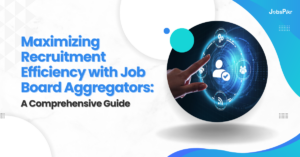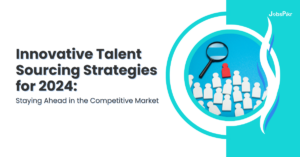Introduction to Job Data Analysis Tools
Software solutions for job data analysis are crucial for analyzing information related to employment. Job data analysis tools aid businesses in forming evidence-based decisions on hiring processes, employee development, performance assessments, and anticipating upcoming personnel requirements.
Given the increasing significance of utilizing job data analysis tools in 2024, it is crucial to recognize their value in gathering, arranging, deciphering, and representing vast quantities of job data effectively. By doing so, HR specialists and business analysts can detect patterns, foresee shifts in the market, and enhance workforce administration.
Employing the most suitable tools can significantly impact a company’s capacity to draw high-caliber candidates and attain exceptional operational efficiency.
The Rise of Data-Driven Recruitment
The transformation of recruitment is evident through the emergence of big data, which allows companies to utilize extensive data quantities for optimizing their hiring procedures:

Image Source: Data-Driven Recruitment: The Benefits and 5 Best Practices – AIHR
- Predictive analytics enables the anticipation of future staffing needs by analyzing trends and patterns.
- Talent analytics focus on identifying characteristics of successful employees to find similar candidates.
- Recruitment automation tools sift through resumes swiftly, spotting ideal candidates based on predetermined criteria.
- Diversity hiring tools assist in creating a balanced workforce by analyzing demographic data.
Decision-makers rely on these dashboards to quickly spot trends, tackle issues, and take advantage of possibilities as they appear, maintaining a competitive advantage in the ever-evolving employment market.
Revolutionizing Job Search with Artificial Intelligence
The integration of AI into job search platforms has significantly enhanced the employment landscape. In 2024, it’s evident that:

Image Source: How Can AI Help in Your Job Search: An In-Depth Guide
- AI-Powered Resume Analysis: Applicants now receive feedback on their resumes, tailored to match the job criteria, thanks to advanced natural language processing.
- Intelligent Job Matching: Machine learning algorithms assess candidates’ profiles and recommend jobs aligning with their skills and previous experience.
- Automated Interview Scheduling: AI-driven systems coordinate interviews efficiently, saving time for both employers and job seekers.
- Predictive Career Pathing: AI aids in forecasting future career trends and job roles, enabling users to make informed decisions about their professional growth.
- Enhanced Employer-Candidate Fit: Through data analytics, AI helps in ascertaining the compatibility between an employer’s requirements and a candidate’s potential, mutually benefiting both parties.
Comprehensive Analytics Platforms for Talent Acquisition
In the cutthroat world of recruiting top talent, all-encompassing analytics platforms are indispensable resources. They enable HR professionals to:
- Gather data on sourcing efficiency and candidate engagement
- Analyze recruitment marketing ROI
- Predict hiring trends using AI and machine learning algorithms
- Track real-time analytics for dynamic decision-making
- Enhance candidate experience through personalized interactions
- Integrate with existing HR systems for streamlined operations
By utilizing job data analysis platforms, companies can secure a strategic benefit when it comes to sourcing, employing, and maintaining exceptional talent.
Customizable Dashboards for Real-Time Data Monitoring
In job data analysis, customizable HR dashboards stand out for their capacity to track metrics in real-time. They empower users to:
- Tailor views to highlight relevant data streams
- Refresh dynamically for up-to-the-minute insights
- Integrate various data sources for a holistic view
- Configure alerts for key performance indicators
These dashboards are pivotal for decision-makers to swiftly identify trends, address concerns, and capitalize on opportunities as they arise, ensuring a strategic edge in the competitive job market landscape.
Predictive Analytics: Forecasting Hiring Needs
Predictive analytics tools have emerged as essential assets for forecasting hiring needs. By examining past data, market patterns, and internal statistics, these systems can accurately estimate forthcoming personnel necessities. Employers integrating such technology can:
- Identify skill gaps proactively
- Adjust recruitment strategies ahead of market shifts
- Ensure a competitive edge in talent acquisition
- Optimize workforce planning
- Minimize hiring costs by predicting peak hiring periods
As job data analysis evolves, predictive analytics remains a key instrument for informed decision-making in talent management.
Integrating with Existing HR Systems for Seamless Job Data Analysis
To fully leverage job data analysis tools, integration with current HR systems is essential. These tools should:
- Connect effortlessly with human resource information systems (HRIS), applicant tracking systems (ATS), and payroll systems.
- Support the import and export of data in various formats for compatibility.
- Offer secure API endpoints to maintain data integrity and confidentiality.
- Utilize automation to synchronize data across platforms, reducing the need for manual entry.
- Provide real-time analytics by drawing from live data sources, ensuring that the insights are always up-to-date and actionable.
Organizations can improve efficiency in their operations, make better decisions, and reduce the chances of isolated data by implementing integration.
Conclusion
Using up-to-date toolsets for job data analysis is no longer merely an asset but has become essential in today’s work environment.
It is crucial that professionals utilize sophisticated analytics platforms, artificial intelligence-based job market trackers, real-time trend analysis applications, predictive modeling instruments, and all-encompassing resume optimization solutions to stay current and competitive.
By incorporating these vital resources, both job hunters and HR personnel will be able to glean critical insights, make informed choices, and eventually attain a successful edge in the continually transforming world of employment.




